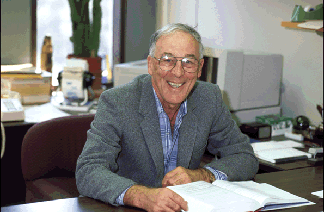
This page was updated last on Tuesday, December 17, 1996

Ph.D., 1956, Florida State University
e-mail: sean.mcglynn@chemgate.chem.lsu.edu
Mail:
Department of Physics and Astronomy
329 Choppin Hall
Louisiana State University
Baton Rouge, LA 70803
Phone:(504) 388-3392
Present Research Interests
Our research interests span chemistry, physics and biology. The major interests are:
Giant Molecules and Atoms: Very highly excited atoms and molecules can be enormous. It is difficult to imagine an oxygen (O2) molecule or sodium (Na) atom to be larger than any biological or synthetic polymer. Yet, that is the case. Such giant molecules/atoms can be generated by placing the system in very high principal quantum number states, say n>100. Because of their size, these systems have very special properties. They are exceedingly polarizable, 106 or more that of the ground state; they are very readily ionized, even by microwave radiation; they may exhibit spin-uncoupling, so that an even-numbered electron system possesses half-integer angular momenta (i.e., behaves like an odd-electron system); they exhibit orbital paramagnetism; they have unusual chemical reactivities; etc. And, above all, it is a fun area in which to work.
Plasmas: A plasma is a highly energetic mix of ions, electrons and excited state species which exists only at very high temperatures (combustion) or in large electrical fields. We are concerned with flames, and with dc and rf fields. We probe the plasma using laser optoacoustics (conversion of light into sound), optogalvanics (conversion of light into electrical effects), Raman spectroscopy, etc. Our aim is to understand plasma kinetics, and the way in which these affect the deposition of thin films, such as diamond, on different surfaces. We also intend to develop the optogalvanic probe into a real-time, feed back regulator of both combustion efficiency and combustion cleanliness (i.e., a good burn with no bad environmental effects).
Radiation Biology: The aim is to relate mutagenicity and carcinogenicity to radiation insult. Unfortunately, this has proven difficult. Part of the problem is that insult may occur in a nanosecond frame (10-9s) whereas cancer development may take years (say, 109s), so that 18 decadic steps may separate insult from result. Our aim has been to find an intermediate point, somewhere in the vicinity of 1 second (10os), such that events at this point can be related to either extreme, thus shortening the number of decadic steps from 18 to 9. We have discovered such an event, namely the set of DNA molecular lesions (and their probability) that is produced by a given radiation. We have shown that these sets of lesions can be used as radiation identifiers. Thus, the gist of our efforts consists of the generation of lesion data bases, better methods of DNA lesion assay, neural networking of these data bases and, eventually, correlation to the carcinogenic terminus.
Selected Publications
W.S. Felps, J.D. Scott and S.P. McGlynn, "Magnetic Circular Dichroism of CD3I in the Vacuum Ultraviolet," J. Chem. Phys. 104:419 (1996).
L. Klasinc, I. Novak and S.P. McGlynn, "Photoelectron Spectra of Compounds with Carbon-Halogen Bonds," Chapter 4 (61 pages) in a book (edited by S. Patai and P. Rappaport) entitled, Organic Chemistry of the Carbon-Halogen Bond, J. Wiley & Sons, New York, 1995.
D. Kumar, R.R. Zinn, T.D. Armstrong, S.P. McGlynn, "The Optogalvanic Effect as a Probe of Plasma Processes," J. Phy. Chem. (M.F.A. El-Sayed Festschrift), 99:7530 (1995).
K. Rupnik and S.P. McGlynn,. "The Simulation of an Unusual MCD Spectrum: 5p->6s Transition of HI," J. Chem. Phys. 103:18 (1995).
